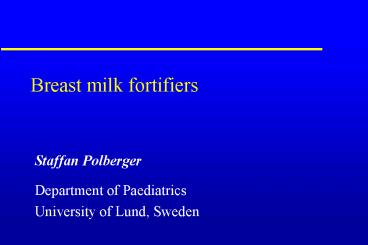Breast milk fortifiers - PowerPoint PPT Presentation
1 / 33
Title:
Breast milk fortifiers
Description:
Breast milk fortifiers. Staffan Polberger. Department of Paediatrics. University of Lund, Sweden ... American Academy of Pediatrics 1985. Goal of nutrition of ... – PowerPoint PPT presentation
Number of Views:742
Avg rating:3.0/5.0
Title: Breast milk fortifiers
1
Breast milk fortifiers
- Staffan Polberger
- Department of Paediatrics
- University of Lund, Sweden
2
Target groups for fortified breast milk
- Preterm infants lt 32 weeks? lt 30 weeks?
- SGA infants?
- Cardiac malformations - extra energy (liquid fat)?
3
Survival of preterm infants, Lund 2000-01
0.71 0.63 0.96 0.75 0.89 0.94
0.96 0.97 Survival rate
4
Feeding of preterm infants
- Own mothers milk (preterm milk)
fortification - Banked milk (if possible preterm milk)
fortification - Preterm formula
- Parenteral nutrition - supplementary
5
Fortification of human milk - preterm infants
- 1919 Ylppö 1 fat
- 1948 Jorpes casein hydrolysate
- 1949 Hess defattad cows milk
- 1980 Lucas human milk formula
- 1982- Hagelberg human milk preparations
- Schanler etc
- 1985- Tönz cows milk preparations
- Modanlou etc
6
Fortification of human milk
- Human milk preparations (research)
- Cows milk preparations (commercial)
7
Why?
- Unfortified human milk is rarely adequate for
nutrition of preterm infants lt 32 weeks (protein,
energy, calcium, phosphorus etc)
8
Goal of nutrition of VLBW infants
- achieving a postnatal growth that
approximates the in utero growth of a normal
fetus at the same postconceptional age appears
to be the most logical approach... - American Academy of Pediatrics 1985
9
Goal of nutrition of VLBW infants
- not because growth per se is important, but
rather because poor growth is a marker of
inadequate nutrition, which in turn can impair
cognitive development - Thus, poor growth is a potential for impaired
cognitive development. - Ziegler 2001
10
Recommended intakes VLBW infants
- Protein 2.9 - 4.0 g/kg/day (ESPGAN) 3.5 -
4.0 g/kg/day (AAP) - Energy 110 - 165 kcal/kg/day (ESPGAN) 120
kcal/kg/day (AAP)
11
(No Transcript)
12
(No Transcript)
13
Commercial fortifiers for preterm infants
- Powdered preparations to be dissolved in milk
- Protein
- Energy (lipids, carbohydrates)
- Minerals (sodium, calcium, phosphate)
- Trace elements, (vitamins)
14
Human milk fortifiers
15
Fortification of human milk
- Blind (full strength to all)
- Semi-quantitative (own or banked term?)
- Individualized
- Intake - milk analyses (protein, energy)
- Metabolic outcome (serum urea)
16
Variation of macronutrients in human milk
- Enormous variability in the composition of
milk expressed by mothers of preterm infants - Hibberd et al. Arch Dis Child 198257658
- Lucas et al. Arch Dis Child 198459831
- Michaelsen et al. JPGN 199011229
- Polberger et al. JPGN 199929332
- Weber et al. Acta Paediatr 200190772
17
Human milk analyses
- MID IR (infrared analysis)
- Protein (Kjeldahl)
- Lipids (Röse-Gottlieb)
- Carbohydrates (Luff-Schorl)
- Energy (calculated)
18
Human milk analyses
- High precision
- Low cost ( 15)
- Ordinary mail (preservative added)
- Results available the following day
19
Human milk analyses
- Own mothers milk Weekly samples
24-hour collections (not spot
samples) Well-shaken samples - Banked milk Prior to routine heat
treatment Well-shaken samples
20
(No Transcript)
21
(No Transcript)
22
- Efficacy of fortification - modest
- Short-term studies (growth, metabolism)
promising, - Long-term studies (neurodevelopment) missing
(one exception) - Ziegler EE. Breast-milk fortification.
- Acta Paediatr 200190720
23
- Individualized fortification is widely believed
to be the the best solution to the variability
problem. The idea to analyze milk and to fortify
it in such a way that each infant always receives
the amount of nutrients that he or she needs is
simple and very attractive. - The trouble is that implementation is difficult.
- Ziegler 2001
24
Individualized feeding of preterm infants 1
- Target group lt 32 weeks
- Individual selection of banked milk according to
protein (and energy) content - Feeding own mothers milk in chronological order
- Protein fortification is not introduced until
enteral intake can not be further increased
(usually at 2-3 weeks of age)
25
Individualized feeding of preterm infants 2
- Individualized fortification to optimal protein
and energy intakes - Fortification is continued during the whole
tube-feeding period - Use of markers of protein status (serum urea,
transthyretin prealbumin) for metabolic
evaluation
26
Serum markers of protein status
- Suggested optimal serum levels in healthy
growing preterm infants (lt 31 gestational weeks) - Serum urea 1 - 3 mmol/L
- Serum transthyretin 90 - 140 mg/L prealbumin
27
Nutritional status
- To optimize the nutritional management of the
premature infant consider together the
neonates nutritional status - Growth parameters
- Nutrient intakes
- Biochemical indices
- Clinical condition
- Anderson DM, Clin Perinatol 200229313
28
(No Transcript)
29
Postdischarge nutrition of preterm infants
- Several studies have examined the effects on
growth and development of nutrient enriched
postdischarge formula in preterm infants and
found improved growth but no effects on
development.
30
Postdischarge nutrition of preterm infants
- Few studies have examined the effect of
nutritional interventions on the breastfed
preterm infant. This is due in part to reluctance
to interfere with the mother-infant dyad, and
because of the other non-nutritional benefits of
breast-feeding. - Griffin IJ, Clin Perinatol 200229327
31
- When assessing nutrition of preterm and other
sick newborn infants - Consider the quality of breast milk or
formula, not only the quantity
32
- NUTRITION of preterm infants
- is not only a matter for nurses
- but also for DOCTORS!
33
(No Transcript)

